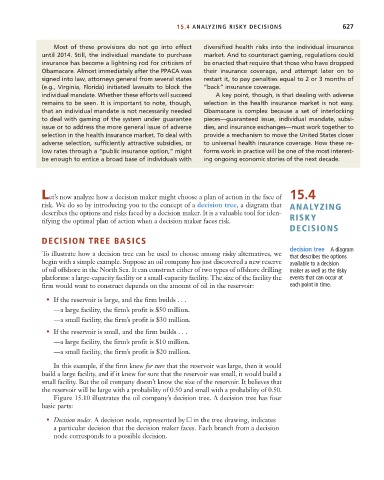Page 653 - Microeconomics, Fourth Edition
P. 653
c15riskandinformation.qxd 8/16/10 11:10 AM Page 627
15.4 ANALYZING RISKY DECISIONS 627
Most of these provisions do not go into effect diversified health risks into the individual insurance
until 2014. Still, the individual mandate to purchase market. And to counteract gaming, regulations could
insurance has become a lightning rod for criticism of be enacted that require that those who have dropped
Obamacare. Almost immediately after the PPACA was their insurance coverage, and attempt later on to
signed into law, attorneys general from several states restart it, to pay penalties equal to 2 or 3 months of
(e.g., Virginia, Florida) initiated lawsuits to block the “back” insurance coverage.
individual mandate. Whether these efforts will succeed A key point, though, is that dealing with adverse
remains to be seen. It is important to note, though, selection in the health insurance market is not easy.
that an individual mandate is not necessarily needed Obamacare is complex because a set of interlocking
to deal with gaming of the system under guarantee pieces—guaranteed issue, individual mandate, subsi-
issue or to address the more general issue of adverse dies, and insurance exchanges—must work together to
selection in the health insurance market. To deal with provide a mechanism to move the United States closer
adverse selection, sufficiently attractive subsidies, or to universal health insurance coverage. How these re-
low rates through a “public insurance option,” might forms work in practice will be one of the most interest-
be enough to entice a broad base of individuals with ing ongoing economic stories of the next decade.
Let’s now analyze how a decision maker might choose a plan of action in the face of 15.4
risk. We do so by introducing you to the concept of a decision tree, a diagram that ANALYZING
describes the options and risks faced by a decision maker. It is a valuable tool for iden-
tifying the optimal plan of action when a decision maker faces risk. RISKY
DECISIONS
DECISION TREE BASICS
decision tree A diagram
To illustrate how a decision tree can be used to choose among risky alternatives, we that describes the options
begin with a simple example. Suppose an oil company has just discovered a new reserve available to a decision
of oil offshore in the North Sea. It can construct either of two types of offshore drilling maker as well as the risky
platforms: a large-capacity facility or a small-capacity facility. The size of the facility the events that can occur at
firm would want to construct depends on the amount of oil in the reservoir: each point in time.
• If the reservoir is large, and the firm builds . . .
—a large facility, the firm’s profit is $50 million.
—a small facility, the firm’s profit is $30 million.
• If the reservoir is small, and the firm builds . . .
—a large facility, the firm’s profit is $10 million.
—a small facility, the firm’s profit is $20 million.
In this example, if the firm knew for sure that the reservoir was large, then it would
build a large facility, and if it knew for sure that the reservoir was small, it would build a
small facility. But the oil company doesn’t know the size of the reservoir. It believes that
the reservoir will be large with a probability of 0.50 and small with a probability of 0.50.
Figure 15.10 illustrates the oil company’s decision tree. A decision tree has four
basic parts:
• Decision nodes. A decision node, represented by n in the tree drawing, indicates
a particular decision that the decision maker faces. Each branch from a decision
node corresponds to a possible decision.

